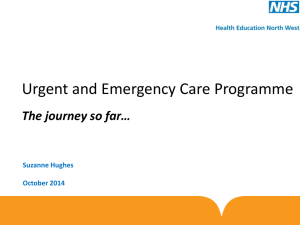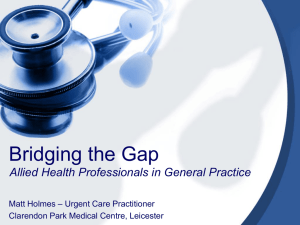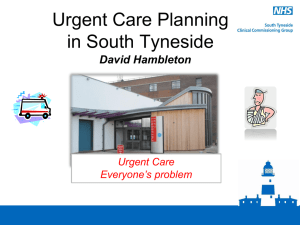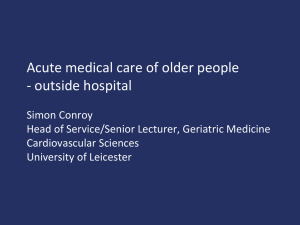Lowering Your Emergency Department Costs
advertisement
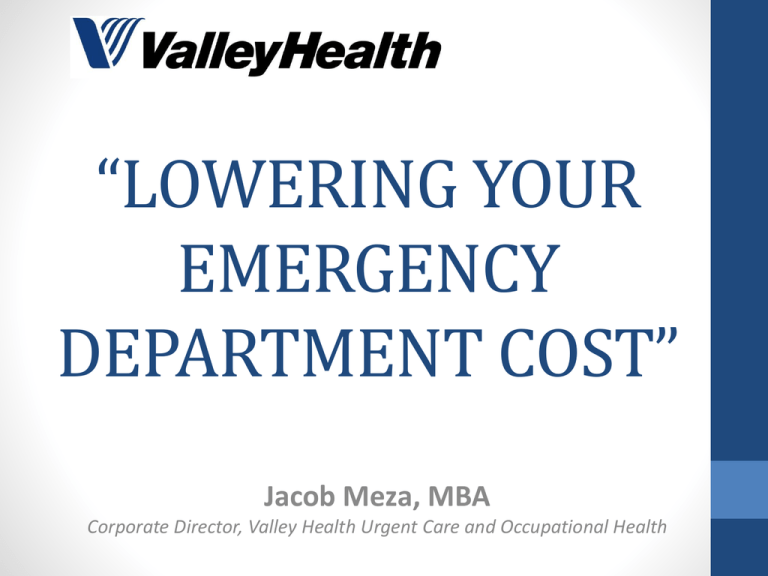
“LOWERING YOUR EMERGENCY DEPARTMENT COST” Jacob Meza, MBA Corporate Director, Valley Health Urgent Care and Occupational Health Employee Benefits…The Problem Healthcare costs have risen an average of 11.1% and now comprise 14.6% of employees’ mean gross annual salary according to a recent survey from ‘Salary.com.’ The high cost of health insurance is the #1 concern among small business owners, according to a study released in August by the National Federation on Independent Business. 1/3 of Americans say, not having enough to pay for healthcare is the biggest concern facing our nation in retirement, according to a new survey from Edward Jones. While employee benefit costs increase, the ability to continue to participate in retirement plans become challenged. National Premium Increases $0 $2,000 $4,000 $6,000 $11,480 $10,880 $3,695 2004 $9,950 $3,383 2003 1999 $12,106 $4,024 2005 $9,068 $3,083 $2,196 Single Coverage $8,003 $2,689 $2,471 $14,000 $12,680 $4,242 2006 2000 $12,000 $4,479 2007 2001 $10,000 $4,704 2008 2002 $8,000 $7,061 Family Coverage $6,438 $5,791 Estimate is statistically different from estimate for the previous year shown (p,.05). Source: Kaiser/HRET Survey of Employer-Sponsored Health Benefits, 1999-2008 Premium Factors Non-controllable Geographical Location & Employee Demographics High dollar claimants…20% of the population drive 80% of the claims Controllable Plan design DRIVES utilization…utilization drives premium increases Generic vs. Brand name drug utilization Usage: Emergency Room versus Urgent Care versus Primary Care Access to Care (PCP) (Current Physician Access vs. Patient Demand) According to the Department of Health and Human Services (HHS), as of June 2011, there are nearly 67 million people living in a primary care Health Professional Shortage Area in the United States.1 For American’s who do have a regular physician: • only 57% of Americans report having access to same or next-day • appointments with their physicians 63% report difficulty getting access to care on nights, weekends or holidays without going to the emergency room.2 Twenty percent (20%) of adults waited six (6) days or more to see a doctor when they were sick in 2010.3 1. 2. 3. Designated Health Professional Shortage Area Statistics. Office of Shortage Designation, Bureau of Health Resources and Services Administration (HRSA), U.S. Department of Health & Human Services. Accessed July 5, 2011. http://ersrs.hrsa.gov/ReportServer?/HGDW_Reports/BCD_HPSA/BCD_HPSA_SCR50_Smry&rs:Format=HTML3.2 Primary Care Access: An Essential Building Block of Health Reform. March 2009. National Association of Community Health Centers. Accessed June 22, 2011. http://www.nachc.org/client/documents/pressreleases/PrimaryCareAccessRPT.pdf 2010 Health Policy Survey in Eleven Countries. Schoen, C. and Osborn, R. The Commonwealth Fund. Accessed July 5, 2011. http://www.commonwealthfund.org/Content/Surveys/2010/Nov/2010]International]Survey.aspx Access to Care (ED) (Current Emergency Department Realities) The majority of the nation’s emergency departments report they are operating “at or over capacity.”1 Emergency department visit rates increased at twice the rate of US population growth from 1997 to 2007.2 Average ED visit wait times have increased in each of the past several years, rising to over 4 hours in 2009.3 In addition to patient boarding, a documented contributor to overcrowding is non-emergency care delivered in the emergency department. (Recently, several state Medicaid directors have begun organizing state-funded programs to reduce ED visits used for primary care.)4 1. 2. 3. How Overcrowding Affects Your Access to Emergency Care. n.d. American College of Emergency Physicians. Accessed July 6, 2011. http://www.acep.org/Content.aspx?id=25906&terms=overcrowding 2010 Emergency Department Pulse Report. Press Ganey. Accessed August 17, 2011. http://www.pressganey.com/newsLanding/10]09]19/Emergency_Department_Pulse_Report_2010.aspx As Hospitals Push ERs, States Medicaid Budgets Pressured. August 22, 2011. Galewitz, P. Kaiser Health News. Accessed August 24, 2011. http://www.kaiserhealthnews.org/Stories/2011/August/23/ER]Diversions]Washington]Post.aspx Access to Care (UC) Since the mid-90’s the industry has grown rapidly to between 4,000 & 9,000 facilities according to the Urgent Care Association of America, the industry's trade association.1 Urgent Cares provide walk-in, no-appointment basis for acute illness or injury that is not life or limb threatening, and is either beyond the scope or availability of the typical primary care practice or retail clinic. Patient Centers: More than 350 new urgent care centers opened between 2008-2009; and from 2009-2010, 380+ were added. Patient Wait Times: 57% of patients wait 15 minutes or less to be seen; About 80% of all visits are 60 minutes or less.2 Average Urgent Care cost are significantly lower then Emergent Care cost. 1. 2. Urgent Care Association of America. Accessed July 19, 2011. http://www.ucaoa.org/home_abouturgentcare.php http://www.ucaoa.org/resources_stats.php Emergency Room vs. Urgent Care Cost Case Study Franz Ritucci, MD, president of the American Academy of Urgent Care Medicine, saw a Florida woman in her 40s who came to him with shortness of breath and dizziness. Urgent Care Cost: Less than $400 Emergency Room: $2,000 or more Cost Comparisons on Minor Care Minor Care Services Average ED Cost Average Urgent Care Cost Sprains Influenza Minor Lacerations Headaches – Migraine/Tension $1,313 $662 $1,215 $976 $250 $150 $320 $200 Emergency Department Utilization Centers for Disease Control (CDC) The CDC figures there are about 116.8 million ED visits per year and about 32 million of those visits are considered non-emergency care. 1 1. National Hospital Ambulatory Medical Care Survey: 2006 Emergency Department Summary. Pitts S, Niska R, Xu J, Burt C. National health statistics reports; August 6, 2010. no 7. National Center for Health Statistics. 2008 Emergency Department Utilization Anthem BCBS Virginia Found that more than 60% of ED visits for its members were for diagnoses that could have been treated in urgent care centers. 1 After launching a patient education initiative, Anthem saw a 14% decrease in ED visits in ONE year! 2 1,2. Emergency Room Interventions Using Google Maps and Education Empower Consumers to Choose ER Alternatives for Non-Emergency Conditions. June 23, 2011. Wellpoint, Inc. Accessed July 8, 2011. Winchester UC vs. WMC ER 3000 2500 2183 2182 2095 2094 2093 2016 1991 2075 2297 2285 2254 2143 2141 2195 2000 2006 2008 2202 2184 2081 1999 1655 1368 1500 1424 1250 1235 1000 1310 1233 1217 1213 1301 1340 1236 1105 1125 1140 1267 1300 1250 1228 1108 1097 991 UC-Winchester 500 WMC E.D. East 0 Jan-10 Mar-10 May-10 Jul-10 Sep-10 Nov-10 Jan-11 Mar-11 May-11 Low Acuity Patient Volume Comparison (2010-2011) Jul-11 Sep-11 7 GREAT REASONS FOR YOUR EMPLOYEES TO TRY URGENT CARE 1. No appointments needed: Just walk right in! 2. Convenient hours: Clinics are open 7 days a week, with extended evening, weekend and holiday hours, just like the ER. 3. Less waiting: The average ER visit tops 4 hours; while urgent care visits are generally an hour or less. 4. Lower prices: Lower copays and out-of-pocket costs, with prices averaging $110-$250, compared to ER costs of $600 to $2,000.1 5. Many locations: With approximately 9,000 (and growing) centers nationwide, you can find a location quickly near your home or job. 6. Fully staffed by doctors: VH UC clinics are always overseen by doctors. 7. Connections with local ERs: If you need more extensive care, you’ll be referred to the closest ER. 1 Average Urgent Care and Emergency Room Pricing. Samples pulled from random charts within Valley Health. Actual costs may vary. 4 GREAT REASONS FOR EMPLOYERS TO PROMOTE URGENT CARES Over 450% less cost on 30%-60% of ED visits annually A lower annual utilization cost = less premium increase Less premium increase = better benefits with less employee out-of-pocket expenses Better benefits mean happier employees and less stressed employers 607 E. Jubal Early Drive, Winchester, VA Valley Health Urgent Care, Front Royal WMH Outpatient Center , 120 N. Commerce Avenue Hours: Weekdays 8 a.m. to 8 p.m. Weekends 9 a.m. to 6 p.m. On-site Digital Radiology On-site Lab Services Make the Right Choice… Head to the Emergency Department Loss of consciousness or head injury Loss of breath Chest pain Congestive Heart Failure Severe bleeding (internal or external) Obvious fractures Head to Urgent Care: Colds, coughs, sinus infections, bronchitis, flu, fever, ear aches Aches/pains, sprains, strains, bruises, muscle pulls, low back pain Skin conditions, rashes, small cuts, lacerations Small foreign bodies in eye, conjunctivitis, corneal abrasion 1st degree burns, small 2nd degree burns Gastroenteritis of less than 1 day’s duration Bladder or urinary tract infection Thank You!! Questions?

